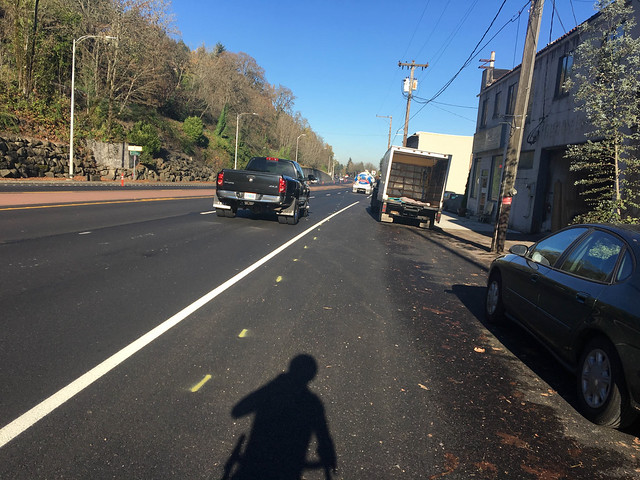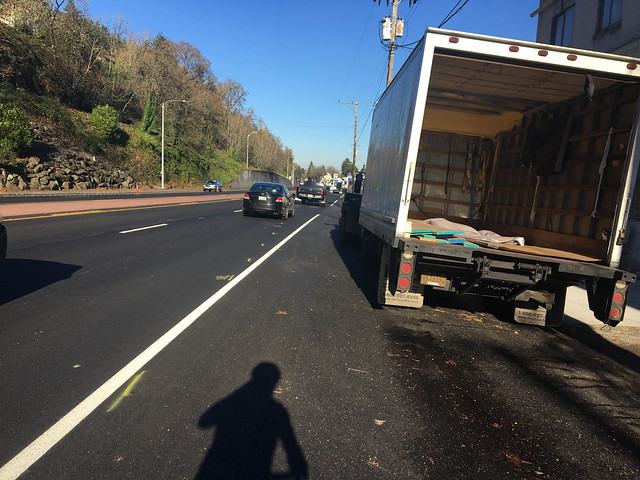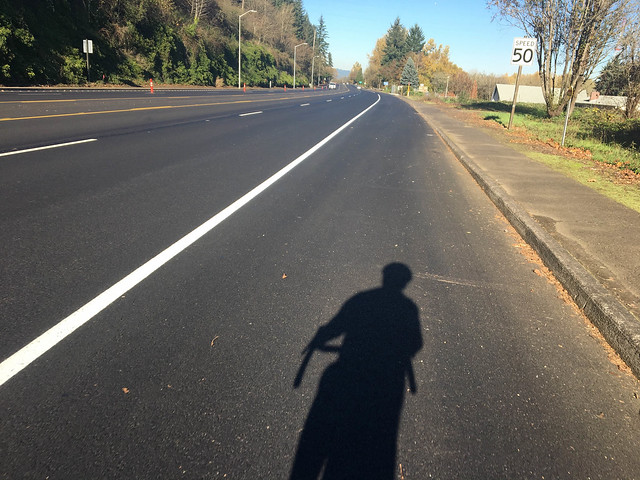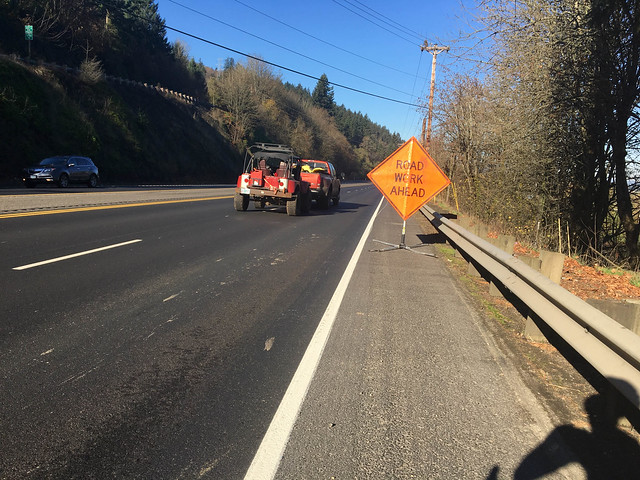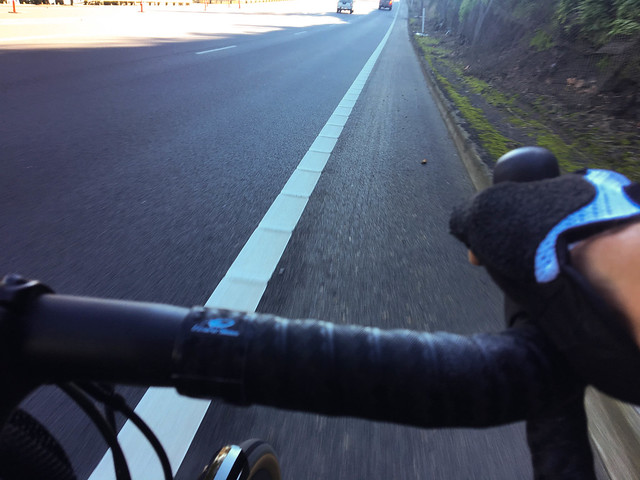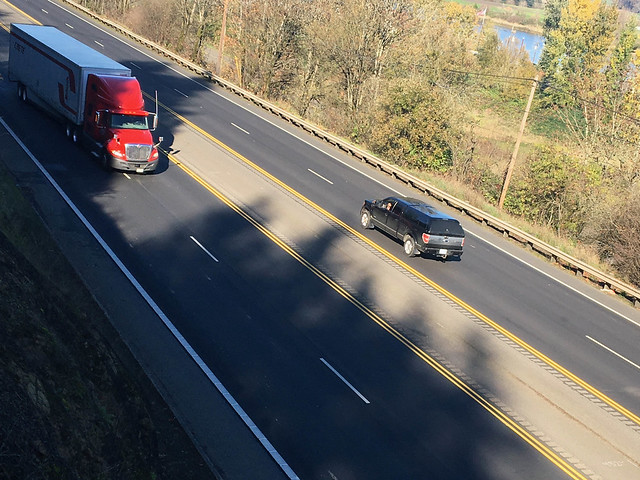The Oregon Department of Transportation has completed a major repaving project on a key section of Highway 30 that’s a popular bike route between the St. Johns Bridge and Sauvie Island.
Back in March we said this was a “golden opportunity” to make the highway better for bicycling. Unfortunately ODOT didn’t make any major improvements to bike access; but the shoulder is now a more consistent width throughout the project’s seven-miles (between the bridge and McNamee Road). We were also disappointed that the shoulder wasn’t striped until a few days ago — well over a week after all the lanes for auto use were completed and striped.
Portlander Ira Ryan (co-founder of Breadwinner Cycles) pointed out the lack of striping in a post on Instagram:
A photo posted by Ira Ryan (@iraryancycles) on
I contacted ODOT about the lack of shoulder striping and pointed out that it created dangerous conditions for bicycle riders — especially on a highway that has a 50 mile-per-hour speed limit, a high volume of truck traffic, and is very popular for cycling. ODOT Community Affairs Coordinator Susan Hanson said the striping wasn’t finished because the contractor didn’t have enough days of dry weather to do the installation. In a follow-up question I asked Hanson to try and understand how it feels to be a bicycle rider when all the striping needed for driving was prioritized and completed despite the weather.
“I do understand your view on the order the striping was done in,” Hanson replied. “We will definitely keep that in mind for future projects for the shoulder striping to be done earlier by the striping sub-contractor.”
Hanson also shared the details on how this project has improved the shoulder for cycling:
The lane and shoulder widths have been standardized to make them more consistent throughout the corridor and provide a wider and more consistent shoulder width for cyclists in response to their concerns.
…The inside lane will be 11 feet wide and the outside lane will be 12 feet wide. The 12 foot outside lane is required for trucks and buses and the 11 foot inside lane is very adequate for cars. This change often results in wider shoulders that are better for cyclists safety.
The shoulders on US 30 in the project area will now be a minimum of 6 feet wide wherever possible. There are a only couple of areas: one just south of Linnton and one around Bridge Avenue where the shoulder will only be 5 feet wide for a short distance.
Advertisement
I rode in the area on Tuesday and can confirm that the striping is finally complete.
It’s important to note that there is a distinction between a shoulder and a bike lane. The stretch of Highway 30 between the St. Johns Bridge and Sauvie Island is technically considered a shoulder. This means it doesn’t have the same legal standing that a bicycle-only lane would have. It also comes with just a four-inch white stripe (fog line) instead of a six-inch stripe. And you won’t see any bike lane symbols.
Here are some photos of how it looks starting northbound south of the Linnton neighborhood where the speed limit is 35 mph…
The new pavement is nice and smooth; but I worry that it only encourages higher speeds because people don’t have bumps or potholes to worry about.
As you get into Linnton, the same danger spots remain. This fabrication shop’s truck is always pinching the shoulder in this location…
Then you have the section with lots of big driveways where the shoulder narrows and drops several times…
North of Linnton, the shoulder opens way up and there aren’t any driveways to worry about. Unfortunately the speed limit goes up to 50 mph…
And unfortunately ODOT’s sub-contractor doesn’t appear to care at all about people who travel in the shoulder. They placed several of these signs on both sides of the highway, forcing me to merge with people driving over 50 mph…
In the southbound direction, I was happy to see that ODOT has added bumps to the shoulder lane stripe. These will hopefully be a visual and audible reminder to people in cars to stay away from the shoulder unless they need to park for an emergency…
While ODOT is proud of what they’ve done for bicycle riders in this project, I didn’t feel much difference overall. The fact remains there’s a lot more that should be done. Given the importance of this this segment of highway in the regional bike network, it should be considered a bicycle safety corridor with striping, signage, and other design elements that make cycling as low-stress as possible and makes it clear to users they should expect bicycle traffic. As you can see in the overhead image below there’s a painted center median and the standard lanes give motorized vehicle users more than enough space.
Hopefully in the future we can make more — and more significant — bicycle access upgrades on Highway 30. Until then, ride with caution and make sure you use the ORCycle app to report problems and maintenance needs directly to ODOT.
Have you ridden this yet? What do you think?
— Jonathan Maus, (503) 706-8804 – jonathan@bikeportland.org
BikePortland is supported by the community (that means you!). Please become a subscriber or make a donation today.


